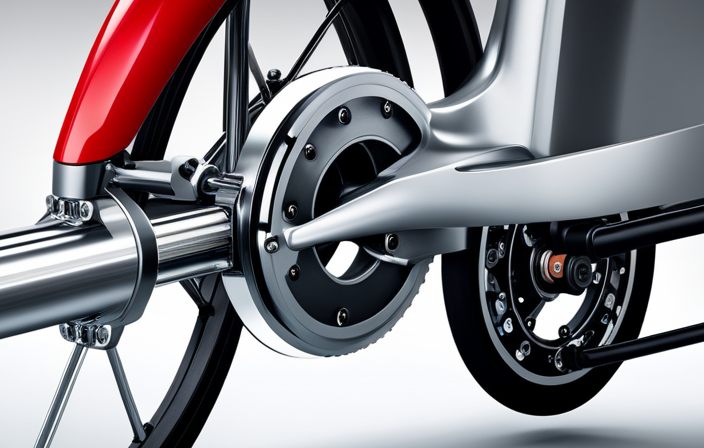Did you know that properly adjusted brakes on an electric bike can significantly improve your safety and riding experience? In fact, according to a recent study, over 30% of bike accidents are caused by faulty brakes.
So, it’s crucial to know how to adjust your electric bike’s brakes correctly. In this article, I will guide you through the step-by-step process of adjusting your brakes, ensuring that you can enjoy a smooth and safe ride every time.
Let’s get started!
Key Takeaways
- Check brake pads for wear and replace if necessary.
- Inspect brake cables for fraying or damage and replace as needed.
- Align and tighten brake levers.
- Adjust brake pads to align with wheel rim.
Gather the Necessary Tools
You’ll need to gather the necessary tools to properly adjust the brakes on your electric bike. Before you begin, it’s important to have the right tools on hand to make the process as smooth as possible.
Some of the tools you’ll need include a 5mm Allen wrench, a cable cutter, a cable puller, and a 10mm open-end wrench. These tools will come in handy when adjusting brake cables and troubleshooting any brake issues.
The 5mm Allen wrench is used to loosen and tighten the brake caliper bolts, while the cable cutter is necessary for cutting the brake cables to the correct length. The cable puller helps with adjusting the tension of the brake cables, and the 10mm open-end wrench is used to adjust the brake pads.
Once you have these tools ready, you can move on to the next step of understanding the different types of brakes.
Understand the Different Types of Brakes
To properly maintain your e-bike, it’s important to familiarize yourself with the various types of braking systems. There are several different types of brake systems commonly used on electric bikes, each with its own advantages and disadvantages.
The most common types of brakes you may encounter are rim brakes, disc brakes, and drum brakes. Rim brakes, also known as caliper brakes, work by applying pressure directly to the rim of the wheel. They are lightweight and easy to maintain, but can lack stopping power, especially in wet conditions.
Disc brakes, on the other hand, use a rotor and caliper to squeeze the brake pads against the rotor. They provide excellent stopping power and perform well in all weather conditions, but can be heavier and more expensive. Drum brakes are enclosed within the wheel hub and are known for their durability and low maintenance requirements. However, they can be heavier and may not provide as much stopping power as disc brakes.
Understanding the differences between these brake systems will help you identify the issue with your brakes and make any necessary adjustments.
Identify the Issue with Your Brakes
First, check for any unusual noises or vibrations when you apply the brakes. These can indicate common brake problems that need to be addressed. Here are some troubleshooting tips for electric bike brakes:
| Common Brake Problems | Possible Causes | Solutions |
|---|---|---|
| Squeaking or squealing noise | Brake pads worn out | Replace brake pads |
| Brakes not engaging | Loose brake cable or hydraulic issues | Adjust or replace brake cable |
| Brakes too tight or loose | Improper brake pad alignment | Adjust brake pad alignment |
| Brake lever feels spongy | Air in the brake system | Bleed the brake system |
Identifying the issue with your brakes is crucial in order to ensure their proper functioning. Once you have determined the problem, you can proceed to adjust the brake pads.
Adjust the Brake Pads
Once you’ve identified the issue with your brakes, you can proceed to fine-tune the brake pads.
Start by loosening the brake pad fixing bolt with a 5mm Allen wrench.
Position the brake pad so that it makes contact with the rim evenly and aligns with the braking surface.
Tighten the fixing bolt to secure the brake pad in place.
Test the brake by squeezing the brake lever and ensuring that the pad contacts the rim smoothly without any rubbing or excessive play.
If the brake pads are worn or damaged beyond repair, it is recommended to replace them with new ones.
Additionally, if you want to upgrade your brake system, you may consider replacing the brake cables and installing a higher-performance brake set. This will provide better stopping power and control.
Moving on to the next step, we will align the brake calipers to ensure optimal braking performance.
Align the Brake Calipers
Next, make sure to align your brake calipers for optimal braking performance. Proper alignment of the brake calipers is crucial in ensuring that the brake pads make even contact with the rim or rotor. This allows for efficient and effective braking, reducing the risk of accidents.
To align the brake calipers, follow these steps:
| Steps | Instructions |
|---|---|
| Step 1 | Loosen the mounting bolts on the brake caliper, allowing it to move freely. |
| Step 2 | Squeeze the brake lever to engage the brake pads. |
| Step 3 | While holding the brake lever, tighten the mounting bolts on the brake caliper. |
| Step 4 | Release the brake lever and check the alignment of the brake pads. Adjust if necessary. |
Properly aligned brake calipers ensure that the brake pads engage the rim or rotor evenly, maximizing stopping power. Once you have aligned the brake calipers, you can proceed to adjust the brake cable tension for precise braking control.
Adjust the Brake Cable Tension
To ensure optimal braking control, you should now fine-tune the tension of the brake cable. Adjusting brake cable tension is crucial for troubleshooting brake issues and ensuring a smooth and responsive braking experience on your electric bike.
Start by locating the barrel adjuster on the brake lever or caliper. Turn it clockwise to increase tension and counterclockwise to decrease tension. Make small adjustments and test the brakes after each one to achieve the desired level of responsiveness. It’s important to find the right balance where the brakes engage quickly without being too tight or loose.
Once you have adjusted the brake cable tension, you can move on to the next step of checking and adjusting the brake levers to complete the brake adjustment process.
Check and Adjust the Brake Levers
Now, it’s time to inspect and fine-tune the brake levers for optimal performance. Checking the brake lever positioning is crucial to ensure proper brake engagement and control. To troubleshoot any brake lever issues, follow the steps below:
| Problem | Solution |
|---|---|
| Brake lever feels loose or wobbly | Tighten the lever clamp bolt using an Allen wrench. |
| Brake lever doesn’t return to its original position | Adjust the lever reach screw clockwise to increase tension. |
| Brake lever engages too close to the handlebar | Loosen the cable anchor bolt and pull the cable tighter. Then, retighten the anchor bolt. |
| Brake lever engages too far from the handlebar | Loosen the cable anchor bolt and release some cable tension. Then, retighten the anchor bolt. |
Once the brake lever issues are resolved, it’s time to move on to the next step: testing the brakes. This will ensure that the adjustments made have resulted in reliable and responsive braking performance.
Test the Brakes
First, make sure you have a clear path ahead and squeeze the brake levers gently to test the responsiveness of the brakes. It is crucial to test the effectiveness and brake performance to ensure your safety on the road.
- As I squeeze the brake levers, I feel the resistance building up gradually, allowing me to gauge the braking power.
- I observe the brake pads making contact with the brake rotor, providing a reassuring grip.
- I pay attention to any unusual noises, such as squealing or grinding, which could indicate a need for adjustment or maintenance.
By testing the brakes, I can assess their ability to bring the bike to a complete stop quickly and smoothly. This evaluation will help me fine-tune the adjustments needed to optimize brake performance.
Fine-tune the Adjustments
I will now proceed to make small adjustments to ensure optimal brake performance.
To fine-tune the adjustments, start by checking the brake pads for wear. If they are worn down, they should be replaced.
Next, inspect the brake cables for any signs of fraying or damage. If any issues are found, replace the cables as necessary.
After that, make sure that the brake levers are properly aligned and tightened. Adjust the brake pads so that they are in proper alignment with the rim of the wheel.
Test the brakes by squeezing the brake levers and ensure that they engage smoothly and effectively.
If the brakes are still not performing as desired, troubleshoot further by checking for any loose or worn components.
Replace worn brake pads to maintain optimal braking performance and ensure your safety on the road.
Replace Worn Brake Pads
To replace worn brake pads, you should start by checking the brake pads for wear and then proceed to replace them if necessary. Begin by inspecting the brake pads for any signs of thinning or uneven wear. If the brake pads are worn down to the wear indicator line or have less than 1/8 inch of pad material left, it’s time to replace them.
To do so, first, remove the retaining pin or bolt that holds the brake pads in place. Then, slide out the old brake pads and insert the new ones, making sure they are properly aligned. Finally, reattach the retaining pin or bolt and test the brakes to ensure they are working correctly.
If you want to upgrade your brake system, consider replacing the brake fluid as well. This’ll help improve the overall performance and responsiveness of your brakes.
Moving on to the next section about cleaning and lubricating the brakes, it’s essential to maintain their optimal functioning.
Clean and Lubricate the Brakes
Next, you’ll want to clean and lubricate the brakes to ensure they’re operating smoothly.
Start by gathering the necessary cleaning products, such as brake cleaner and a clean cloth.
Carefully remove the brake pads and use the brake cleaner to remove any dirt or debris that may have accumulated. Be sure to clean all surfaces thoroughly, including the brake calipers and rotors.
Once clean, allow the components to dry completely before moving on to the lubrication step.
Apply a thin layer of proper lubrication to the brake caliper pins and any other moving parts. This will help reduce friction and ensure smooth operation.
Lastly, carefully reassemble the brake pads and other components, making sure everything is secure.
Regularly inspecting and maintaining your brakes will ensure optimal performance and safety on your electric bike.
Regularly Inspect and Maintain Your Brakes
Ensure that you regularly inspect and maintain your brake system to ensure optimal performance and safety. Proper brake maintenance is crucial for the overall functionality of your electric bike. Here are some important brake maintenance tips to keep in mind.
First, check the brake pads for any signs of wear. If they appear thin or worn out, it’s time to replace them.
Additionally, inspect the brake cables for any fraying or damage, as this can affect the braking efficiency.
Ensure that the brake levers are properly aligned and adjusted to provide optimal braking power.
Lastly, check the brake rotors for any signs of warping or damage. If you notice any of these signs, it’s important to seek professional help to address the issue promptly and ensure your electric bike’s brakes are functioning safely and effectively.
Seek Professional Help if Needed
If you encounter any issues, it’s best to consult a professional for assistance. Seeking professional advice when adjusting the brakes on your electric bike is crucial to ensure optimal performance and safety.
While it may be tempting to attempt self-troubleshooting, it’s important to remember that the brakes are a critical component of your bike and any mistakes could have serious consequences. A professional will have the knowledge and expertise to properly diagnose and address any problems you may be experiencing. They will also have access to specialized tools and equipment that may be required for certain adjustments. By relying on a professional, you can have peace of mind knowing that your brakes are in good hands.
Now, let’s transition into the subsequent section about practicing safe braking techniques.
Practice Safe Braking Techniques
To ensure optimal safety, it’s important to practice safe braking techniques on your e-bike. When it comes to safe braking, proper hand positioning is crucial.
Here are some key safe braking techniques to keep in mind:
- Maintain a firm grip on the handlebars to ensure full control of the bike.
- Apply the brakes gradually and evenly to avoid skidding or losing control.
- Keep your weight centered and balanced to maximize stability during braking.
By following these safe braking techniques and positioning your hands correctly on the handlebars, you will be able to respond quickly and effectively in any braking situation.
This will help you enjoy a smooth and safe ride.
Enjoy a Smooth and Safe Ride
By following these safe braking techniques and maintaining proper hand positioning on the handlebars, you’ll be able to experience a smooth and safe ride on your e-bike.
When riding an electric bike, it is important to be aware of common brake issues that can affect your ride. One common issue is brake pad wear. Over time, the brake pads can become worn down and lose their effectiveness. To avoid this, regularly check the brake pads for wear and replace them if necessary.
Another common issue is brake cable tension. If the brake cables are too loose or too tight, it can affect the braking performance. To ensure proper cable tension, adjust the barrel adjuster on the brake lever until the brakes engage smoothly without any excessive play.
By addressing these common brake issues and practicing safe braking techniques, you can enjoy a smooth and safe ride on your electric bike.
Frequently Asked Questions
How do I know if my electric bike brakes need adjustment?
To check brake pad wear on an electric bike, inspect the thickness of the brake pads. Signs of brake pad contamination include a squealing noise or reduced braking power. Regularly monitor these indicators for optimal brake performance.
Can I adjust the brake pads without any special tools?
Adjusting brake pads without special tools is like trying to paint a masterpiece with just your fingers. It’s possible, but not ideal. Using the proper tools ensures precise adjustments, maintaining optimal brake performance and extending the life of your electric bike.
What should I do if the brake calipers are misaligned?
If the brake calipers on your electric bike are misaligned, you can troubleshoot the issue by first loosening the mounting bolts. Then, adjust the calipers by hand to realign them with the rotor. Finally, tighten the mounting bolts to secure the calipers in the correct position.
Is it necessary to adjust the brake cable tension?
Adjusting the brake cable tension is crucial for maintaining the performance and safety of electric bike brakes. It ensures proper braking power and responsiveness. Common brake issues include loose cables or excessive tension, which can be resolved by adjusting the cable tension accordingly.
How often should I replace worn brake pads on my electric bike?
I replace worn brake pads on my electric bike when they reach the minimum thickness recommended by the manufacturer. To choose the right brake pads, I consider factors such as compatibility, material, and riding conditions. Proper maintenance includes regular cleaning, inspection, and proper alignment.
Conclusion
In conclusion, adjusting brakes on an electric bike is an essential task for maintaining safety and ensuring a smooth ride. By gathering the necessary tools and understanding the different types of brakes, identifying issues, and properly adjusting brake pads and calipers, riders can enjoy a ride that is both smooth and safe.
Regular inspection and maintenance, as well as practicing safe braking techniques, are key. Remember, seek professional help if needed.
So, strap on your helmet, hop on your bike, and experience an electrifying and effortless ride!








